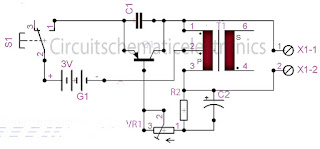Transistor checker tool with circuit

The above sequence is a circuit of development of the transistor circuit tester before, which of course added few more components , and resulting in even be better. Examiners transistor circuit above only knows his gain is only on the collector . In addition to well known techniques of data materials used therein . That is , if the elements germanium and the like which are in the tool is still functioning or vice versa. Part List : R1=330R/0,5W R2=27K R3=1K R4=1K R5,R6=5K6 C1=1uF C2=2,2uF Q1=Socket transistor T1=Transformator output (OT) S1=Switches friction G1=3V X1-1, X1-2=Speaker connector How to test : Emitter associated with foot condensator and resistor R4, Base is connected with one leg transformer OT , The Collector is connected to the foot of R2 and R3. If you hear a hiss , the sound in few seconds it still has not changed means that transistor still disqualify technical data.

































